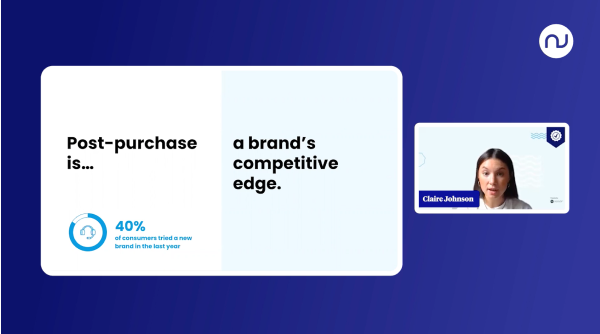



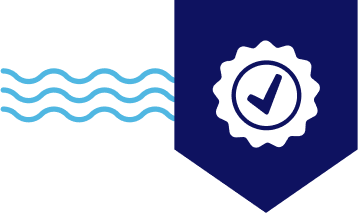





Patients are consumers too. With ever-evolving expectations and higher stakes than typical deliveries, join us as we walk through…
• What patients expect
• How you can meet and exceed patient expectations
• How brands like CVS, Allheart, and Humana have mastered post-purchase
Claire Johnson (00:12)
Hi Everyone!
In this episode of Signed, Sealed, Delivered we’re talking healthcare.
Specifically, we’re talking about how healthcare providers and suppliers can improve profits and patient outcomes using post-purchase.
We’ll start by getting clear on what your patients expect because, after all, they’re consumers at the end of the day. In fact, they’re the most discerning consumers of all because the products and services they purchase shape how long (and how well) they live.
We’ll also give you a kit you can use to meet and exceed your patients’ expectations when it comes to post-purchase.
And, of course, we’ll explain how Narvar can help you set your healthcare brand apart from the competition.
Claire Johnson (01:11)
So to kick it off, what do patients really expect?
55% percent of Americans have a preexisting condition, so that 55% is an active consumer base actively shopping in stores and online for products that will make their life better. They’re spending money, they’re tracking orders, and they’re very tuned into their experience as shoppers.
Whether you’re a traditional pharmacy, a D2C supplement maker, or a hospital system, all the people who visit your website to order medication or supplies expect the very best in customer service for the simple fact their needs aren’t discretionary—they’re essential.
Claire Johnson (02:05)
Unfortunately, most healthcare brands are missing the mark when it comes to the patient experience. There’s a lot of room for improvement, and it's imperative for you as a healthcare provider or supplier to address these experiential needs because those needs cement patient loyalty if you want them to keep buying their health products from your stores.
With that being said, our first recommendation is that you establish crystal-clear delivery expectations up front.
Claire Johnson (02:55)
Prior to a patient making a purchase, what are you doing to ensure they understand exactly when their order will arrive? It’s an important question to answer because, on average, brands that show estimated delivery dates on a product detail page, in the cart, in the checkout flow, and on the order confirmation page, see a 9% reduction in cart abandonment, and a 100% increase in site conversion rates.
Claire Johnson (03:45)
Creating a seamless patient experience is also important. If patients demand a high-level of attention and personalization when they’re waiting for an order from an apparel retailer such as Gap, how much higher do you think their expectations are when they’re waiting for an order that will impact their health and well-being?
There is a lot at stake here for your brand. By giving your patients a seamless way to track an order or obtain information about a return, you’re making it easier for them to keep spending money with you.
Claire Johnson (04:34)
Another recommendation is to add consistent communication throughout that delivery journey and to reduce friction and call volume to your customer service team—about 50% of all calls to a retailer’s customer service team are questions about order status or delivery. So, by getting better with your communication and reducing calls to your call center you can improve the patient experience and your operational efficiency (i.e. fewer needless calls) at the same time.
Claire Johnson (05:39)
At Narvar, we work with several different healthcare providers and suppliers, helping them set pre-purchase expectations, create seamless tracking experiences, consistently communicate throughout the delivery journey, and more.
We do this through our post-purchase platform which is GDPR-compliant, HIPAA-compliant, and ADA-compliant.
Claire Johnson (06:45)
In other words, we help healthcare and wellness brands:
Claire Johnson (07:30)
We even help healthcare and wellness brands provide a cohesive, seamless returns experience.
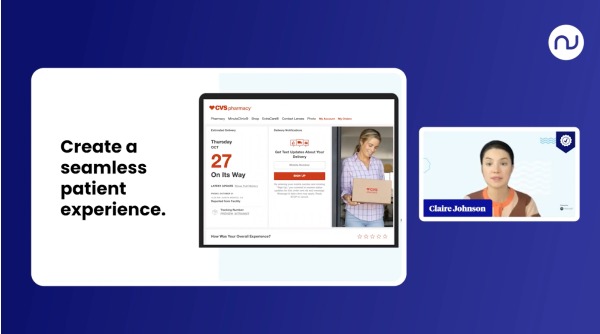
Split shipments (when a multi-product order is delivered in more than one package) are becoming more common, increasing by as much as 27% since the start of the pandemic. While part of the surge in split shipments can be attributed to significant increases in ecommerce transactions since 2020, there are other factors at play.
We’ll walk through the four main factors driving the uptick in split shipments, and your kit to overcome any split shipment hurdles in your way.
Claire Johnson (00:12)
Hi, everyone.
On this episode of Signed, Sealed, Delivered, we're going to talk about split shipments, which are on the rise.
We’re going to define what a split shipment is, what’s fueling their increase, and hope you can reduce the negative impact of split shipments on your business (e.g., an uptick in WISMO calls).
Claire Johnson (00:48)
A split shipment occurs when there's a multi-product order and it's going to be delivered in multiple packages.
Claire Johnson (01:10)
Of and in themselves, split shipments aren't bad because they (generally) drive operational efficiency.
If you’re a retailer, you might be doing split shipments to unlock hyper-local inventory and reduce the time and cost it takes to deliver a product to an end customer.
Claire Johnson (01:42)
Or you might be shipping from different distribution centers, because one distribution center is closer to the end customer but it only contains a portion of a multi-product order. So while it might drive operational efficiency, the downstream impact is that it leaves the customer unsure about what happened to their full order. These downstream issues are especially common for brands working closely with drop shippers.
Claire Johnson (02:20)
Again, having split shipments isn’t a bad thing, but it does come with costs in terms of the customer experience if your post-purchase process isn’t buttoned up.
Claire Johnson (02:46)
At Navar, we help retailers combat any adverse consequences related to split shipments by utilizing proactive email communication that helps customers understand their order is being split into multiple deliveries. As you can see here in these examples from rue21 and Neiman Marcus, shoppers can clearly see what's in each package and they get separate links to track each specific package so they know exactly when each product is arriving.
Claire Johnson (03:23)
We also help retailers with split shipments by offering “daily digest” emails.
LoveSac is a retailer that uses our daily digest emails because their orders sometimes need to be split into over 30 separate boxes. By giving their customers a clear view of everything going on with their order in a single email (instead of 35 different emails), they level-set with customers without overwhelming them. The daily digest emails are also really helpful for multi-product orders that might include products on back orders in them as well.
Claire Johnson (04:32)
Another way that we can also help level-set on those expectations and reduce WISMO from split shipments is with our track product. So this is an inherent piece of the functionality. So if you are using Narvar Track today, just know that your customers are getting their expectations set and hopefully met with this specific piece of functionality. So we are able to understand what's in each exact package and show this item level visibility, so get really granular on the track page so a customer can know exactly what's in that specific order and when that will arrive.
Claire Johnson (05:07)
For those multi-product orders as well, we also break it out so they know what's in each order and what's in each package and when is each one going to arrive through support for multi-shipment. So we're giving that multi-shipment visibility here as well, all in an effort to reduce WISMO and set those customer expectations so you can increase customer lifetime value.
Claire Johnson (05:29)
Finally, if you are a Narvar customer and you would love to learn more, or maybe you are not and would also love to learn more, feel free to request a demo or reach out to one of your Narvar contacts to see how you can help reduce WISMO as a result of split shipments.
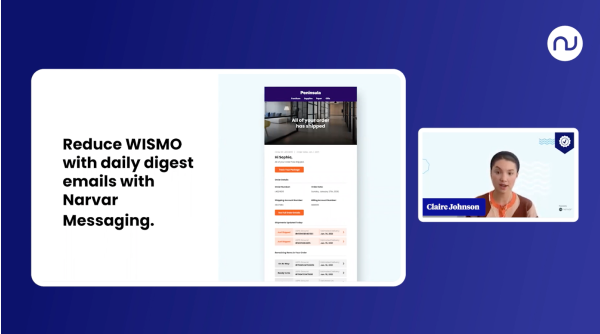
Narvar is now integrated with Klaviyo!
We’ll walk through how you can use this partnership to drive increased LTV for your customers by:
• Enriching customer profiles with post-purchase shipment events
• Powering marketing campaigns with shipment-related activity
• Timing post-purchase follow-ups for peak accuracy and engagement
Claire Johnson (00:17)
Hi everyone, I’m Claire Johnson and this is Signed, Sealed, Delivered.
Today we’re going to talk about the power of integrations, specifically Narvar’s integration with Klaviyo.
We’ll discuss what the integration looks like, how it works, and how you can get started using it.
Claire Johnson (00:56)
For those who are unaware, Klaviyo allows retailers to both consolidate customer level information and use that data to enact different marketing campaigns through both a customer data platform and event-stream processing.
At Narvar, we help retailers communicate with customers about the status of their shipment or order across the entire delivery journey using a series of event-based triggers. So, on the carrier side, we know when an item is on its way, when it's been delivered, and when it's been delayed. We also know when a return is initiated, when it's back at the warehouse, and when it's accepted.
Claire Johnson (01:44)
Through our Klaviyo integration, we make it easy for retailers to increase customer lifetime value and overall pipeline.
When an order is placed, the integration allows us to send that order tracking and shipment information (or return information) to your end customer directly OR through Klaviyo.
Claire Johnson (02:37)
You can use these events to enrich customer profiles and get an added data point as to how a customer is actually experiencing and interacting with your brand.
Additionally, that personalization can enhance future communications and marketing campaigns.
Claire Johnson (02:56)
So, these post-purchase shipment events (and there are a variety of them) are a great way to tailor marketing campaigns.
As an example, in the event a customer experiences a delay or an exception in their delivery journey, it's not the best time for you to run a promotion. Instead, you can use that negative experience to tailor future marketing campaigns or send them a coupon for 20% off their next purchase because of the delay or exception experienced.
Claire Johnson (03:49)
As you build customer profiles in Klaviyo, you can use those profiles to inform future marketing campaigns, get a better understanding of that customer's overall interaction with your brand (their purchase rate, their repurchase rate, etc.) and use that to inform whatever marketing and loyalty strategies you have.
Most importantly, you can power your own post-purchase communication directly in Klaviyo using the triggers Narvar sends to Klaviyo on your behalf.
Claire Johnson (04:35)
Use your public API key in Klaviyo, log into Narvar hub, and give us the public API key. Once you do, order and event data will flow within a couple of days so you can start using Klaviyo to send post-purchase communications.

Showing an estimated delivery date on a PDP or at checkout doesn’t just set clear expectations on the delivery date — it also powers conversion.
Retailers doing it well aren’t just showing a pre-purchase EDD – they’re doing even more. In this episode, we’ll break down:
• How to drive purchase urgency with estimated delivery dates
• Why showing multiple service methods is key to exceeding customer expectations
• What brands using pre-purchase EDDs today are seeing conversion rates double
Claire Johnson (00:18):
Hi, everyone. Welcome to Signed, Sealed, Delivered—Today we're going to talk about powering conversion.
Specifically we’re going to talk about the importance of showing pre-purchase estimated delivery dates prior to get people over the line when they’re thinking about buying.
We're going to show you the different ways you can highlight pre-purchase estimated delivery dates and explain why this powers conversion.
Claire Johnson (00:46)
We’ll also talk through two brands that we work with here at Narvar, and share the results they’re seeing by projecting that estimated delivery date prior to a customer making that purchase.
Claire Johnson (01:00)
So let’s dive in…
Showing an estimated delivery date gives you a competitive edge. If a customer is presented with two different retailers to purchase the same product at the same price, 60% of customers say they’ll make the purchase from the retailer who shares the delivery date.
Claire Johnson (01:34)
Showing an estimated delivery date throughout that customer journey—the product detail page, the checkout page, the order confirmation page, etc.—reduces cart abandonment and drives conversion by setting the right expectations with the customer.
(An added bonus to all this?—When the customer knows exactly when their order will arrive, they’re less likely to burden your customer service centers with an inquiry.).
Claire Johnson (02:09)
There are different elements of showing an estimated delivery date on a PDP or at checkout, and it's not just about showing the date of arrival.
We see a higher amount of conversion when the estimated delivery date is shown throughout the purchase journey—in the cart, at check out, etc.
We see even higher conversion elements when the estimated delivery date is combined with other features (such as a countdown timer) that fuel urgency.
Claire Johnson (02:47)
Showing shipping price is also incredibly important—it’s something people always want to know and failing to include it early in the checkout flow can lead to cart abandonment.
Claire Johnson (03:11)
Something else that has really risen in terms of a demand that consumers have is seeing when they can get a different package across different carrier service methods (e.g., economy shipping, eco-shipping, two-day shipping, etc.).
Claire Johnson (03:37)
If you can, we recommend showing customers multiple carrier service methods for different estimated delivery dates to help boost conversions.
Why—because 52% of customers want alternative shipping methods.
So showing estimated delivery dates across different methods is incredibly important.
Claire Johnson (04:14)
At Navar, our Ship product can accomplish all of this.
It shows pre-purchase estimated delivery dates in a variety of ways to power conversion and lower cart abandonment. For example, Hibbett Sports uses Ship to increase their on-site conversion rates (+3.5%) and reduce their WISMO rates. In fact, they saw WISMO calls to their customer support center drop by an astounding 100%.
Claire Johnson (05:28)
Similarly, On Running uses our Ship product to show estimated delivery dates to customers across the globe. Since partnering with us, they’ve seen a 9% reduction in cart abandonment thanks to the uptick in purchase confidence that’s delivered from showing accurate estimated delivery dates across the customer journey.
Claire Johnson (06:11)
Again, we work with On Running across borders and regions, catering to the different carrier rules and languages of different nations without any hiccups. Achieving this global scale is something we’ve done by connecting all of their distribution centers and their fulfillment network with time and transit tables for the different carriers that they work with to show that accurate estimated delivery date.
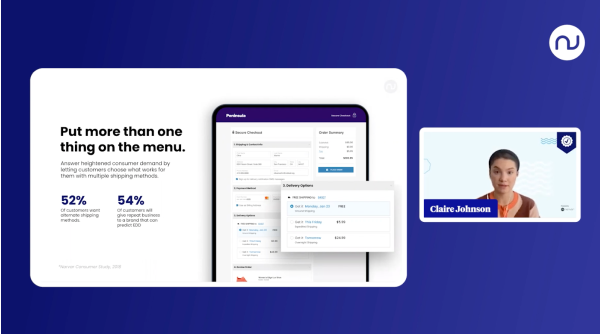
To increase efficiency and boost revenue, Orvis added a free-shipping promotion to their return confirmation emails (Orvis’ alternative to an exchange program).
Consequently, Orvis customers felt the online returns experience became more convenient. As a result, Orvis saw a 124% lift in post-return orders (netting $185,000 in recaptured revenue), and 42% fewer WISMR inquiries to their call center.
Check out this episode where we break down the steps Orvis took to make this happen!
Claire Johnson (00:18):
Hi, everyone. I'm your host, Claire Johnson, and I'm really excited to talk to you today about one of our customers, Orvis—how they created a seamless return experience that led to an uptick of orders from those customers making returns.
Claire Johnson (00:50)
We're going to walk through Orvis’ goals, their pain points, and the solutions they put into place to alleviate those pain points.
Claire Johnson (01:06)
More than anything else, Orvis’ biggest goal was to reduce the service burden placed on their customer support team—a team suffering from an unsustainable level of inquiries related to return initiation and return status (e.g., in-review, accepted, refund issued, etc.).
Claire Johnson (01:40)
In addition to reducing customer inquiry volume, Orivs also sought to create a seamless return experience for the simple fact customers will always want to return products, and the smoother their experience, the stronger their loyalty to the brand will be. Orvis understood that 96% of customers will make an additional purchase form a retailer following a return IF that returns experience is smooth.
Claire Johnson (02:15)
With that understanding, Orvis invested heavily into optimizing their returns flow and technology.
They made it easier to find their return policy, easier to initiate a return, and added detail-rich email notifications to their return flow. Upon going through that flow, Orvis customers now get an email that confirms the return request, provides step-by-step instructions (e.g., Here's your QR code to take to a UPS Store to facilitate the return”), and promotional offers to incentivize loyalty and future purchases. For example, hero banners with a code for free shipping on the next order.
These changes led to an uptick of orders from customers to an incredible extent—a 124% lift in new orders from customers following a return.
Claire Johnson (03:29)
Revamping their approach to returns allowed Orvis to better recapture revenue by a major margin. In just the first few months of the program, they netted almost $200,000 in saved sales. Factor in Orvis’ 42% reduction in WISMR inquiries (i.e., cost savings) and the ROI from this modest post-purchase investment is jaw dropping.
Claire Johnson (04:03)
Improving your return process like this is really, really easy IF you’re running a Narvar Returns program—just such a simple way to keep people happy and spending money with your brand.
Claire Johnson (04:18)
If you would like to learn more about Narvar Returns, how Orvis saw this benefit, how other retailers have partnered to see tremendous benefits as a part of their returns program, by all means, reach out to learn more, and we are happy to get in touch and share.
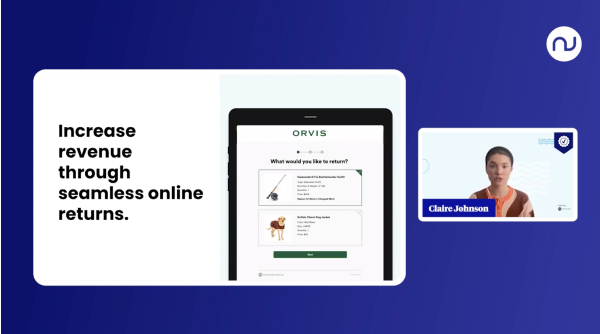
Exceptions cost retailers millions each year. Last mile delivery management tools can mean the difference between “return to sender,” a successful delivery, and a happy customer.
In this episode, we’ll talk through three ways to reduce exceptions up to 50% in the delivery journey while adding in customer conveniences that ensure delivery success.
Claire Johnson (00:05):
Hi everyone! Today we're talking about a topic that impacts us personally and professionally:
Exceptions.
After interviewing hundreds of retailers and monitoring the more than 1,300 retailers on our platform, we understand what types of exceptions are happening right now and how often they're happening.
More importantly, we’ve also learned how you can reduce those exceptions by up to 50% using a few basic strategies.
Claire Johnson (01:00)
Let’s start by answering a basic question: What is an exception?
While there are different types depending on what part of the country you live in, an exception is more or less when a package experiences a delay in transit.
On average, 11% of daily shipping volume experiences an exception.
Again, an exception will look different depending on you (the retailer), the type of package being delivered, or where that package is being delivered.
An exception could be tied to a weather event, traffic conditions, or simply a package being undeliverable (e.g., maybe the customer wasn’t home to sign for release).
Claire Johnson (02:16)
All in all, exceptions cost retailers millions of dollars every year. So what can we leave you with today to make it so that you can reduce the amount of exceptions happening within your network?
The first thing we can leave you with is this:
Give your customers the choice of redirecting their package to a convenient pickup location when exceptions arise.
Claire Johnson (02:46)
For example, Narvar’s partnership with FedEx combined with Narvar’s network of drop-off locations (Walgreens, Michael’s, etc.) makes it so your shoppers can redirect their package to a convenient pickup location directly from their order track page, ensuring delivery success and making it so shoppers can pick their package up when it's convenient for them.
Claire Johnson (03:41)
In many cases, exceptions force retailers to return products to a warehouse, which comes with huge costs because not only are you shipping the package to the customer from point A to point B, but then you're also handling that cost of shipping it back to your warehouse, which is then going to lead to dead inventory and just hurt your ability to sell that product in that specific season for the max amount of dollars.
Allowing shoppers to add delivery instructions is one way to further reduce exceptions. Giving customers the ability to be explicit with their carrier and let them know exactly where they should deliver that package is vital.
Imagine a customer who lives in an apartment building—they might want their package to be left with the doorman, or inside a vestibule, or tucked behind a bush. Delivery instructions make this kind of customized, last-100-feet delivery possible, which helps avoid exceptions.
Claire Johnson (04:34)
Perhaps more importantly, it makes the customer feel like they’re in control.
Claire Johnson (05:13)
Exceptions related to signature release is something we see with luxury retailers or retailers delivering large or bulky items.
Retailers like Gucci or Theory tend to require a signature release upon the receipt of the package because they’re selling high-value products.
To avoid these “missed signature” exceptions, allow your customers to sign for release directly through their order track page.
Claire Johnson (05:56)
BOPIS and curbside pickup are exploding in terms of their popularity as a fulfillment option, and they are here to stay. To keep your customers in lockstep with their orders when they're going to a pickup point, you can use notifications sent through SMS, WhatsApp, or email, to make sure they’re not only aware of their order pickup point but when that order is ready for pickup.
Claire Johnson (07:08)
Another email notification that we talked about briefly in the earlier slide, but I think is really important to hone in on is, when it comes to buy-online-pickup-in-store orders or curbside orders, making it very, very seamless for your customers to know exactly where they need to go when they have to pick that package up and keeping them in lockstep of when it will be ready to pick up.
So we have a whole suite of emails specifically for BOPIS that can make it so that you can provide really detailed instructions to your customers so they know exactly where to go and when to pick that package up. Similarly, when it's actually ready we will then trigger an email notification directly to your customer to let them know that the package is ready and you can leave explicit instructions on bringing your ID, bringing the credit card to confirm the number, meeting at a certain point within the store to, again, make it very, very seamless for the customer.
Claire Johnson (08:01)
And then also, in an effort to reduce the amount of return to warehouse type moments that you might be experiencing today, customers should be reminded that they have something waiting for them.
So through retailers like Sephora that we work with today, they actually send these pickup reminders to their customers, letting them know that they have this order that's waiting for them in store, and they'll send it out multiple times before the seven-day period when an item will eventually get returned.
Claire Johnson (08:27)
So they'll let a customer know, "Hey, don't forget to pick your package up." Maybe a delay... A day, sorry, after it's been ready, and then maybe a day before it needs to go back, or two days before they'll send that message again, giving that customer that 48 hour window or 24 hour window to get the store to pick that package up.
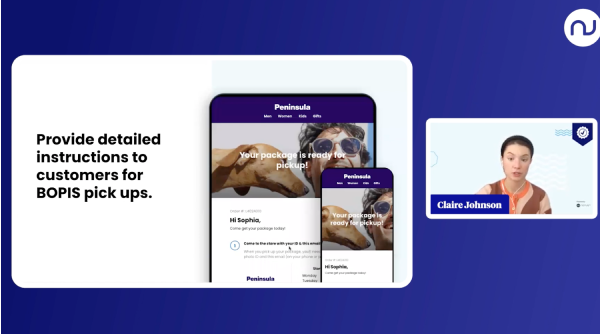
Customers expect returns to be free and easy and brands want to provide a seamless post-purchase experience. The problem is, returns are expensive and are impacting your bottom line.
Let’s talk about returns, how much they cost, and how to reduce costs along the journey:
• Realizing the cost of returns
• How returns impact your bottom-line
• How to reduce costs in post-purchase
Jay Gittens (00:00):
Hey, my name is Jay, and I'm a Product Marketing Manager here at Narvar. This is Signed, Sealed, and Delivered, and today we'll be talking about finding the hidden cost of returns…but before we can do that, we’ve got to answer an important question first: Why do returns matter?
Customers today expect return policies that make it easy for them to buy from their favorite brands and return products with little to no hassle. Meeting that expectation is critical as it leads to stronger retention and higher lifetime value. In fact, 80% of customers will buy from a retailer again and again if the returns process is easy.
That’s why it’s always in a retailer's best interest to maintain a return policy that’s easy to understand and even easier to adhere to.
Jay Gittens (00:52):
Unfortunately, the easiest return policies come with steep costs—especially when you consider anywhere from 20% to 30% of all online orders are returned. Yet the rising cost of returns is often overlooked as retailers over index on acquisition and growth at the expense of profitability.
Consider the cost of returning a $50 product by mail, assuming you cover the cost of the return for the customer. Between postage, transportation, processing, restocking, and reselling (typically at a discount) you’re losing about 60% of that product’s value just to get it back from the customer.
Jay Gittens (01:46):
Another factor you need to consider in your returns calculus is the cost of selling the product in the first place. If a shopper is ultimately going to return a purchase, their initial acquisition cost should be added into the cost of the overall return.
(Never mind that you don’t even know if your returned inventory is resellable—or how long it will take to get it into a sellable state—until you get it back in house. If it can’t be resold, you’ve paid for the return shipping only to take a full writedown on the value of the item.)
So, here's what the equation for a return looks like…
You take your total revenue and subtract 20% of that number (to account for a 20% return rate). Then subtract the cost of acquisition, shipping/logistics, and restocking/reselling.
The number that you’re left with?—That’s the real cost of returns to your business.
Jay Gittens (02:23):
When you look at your final number, it can feel a bit depressing, but there’s good news—I can show you how you can turn your returns process into a competitive advantage that offsets some of that expense. In fact, I can show you how you can retain more revenue and save the sale more often.
Jay Gittens (03:03):
The first thing you need to do is start leveraging local pickup and drop-off points to consolidate your returns costs and get products back faster (which allows for more effective resale).
The next thing you need to do is start customizing your return policies for different customer segments, as doing so makes shoppers more comfortable with the policies you offer while allowing you to mitigate expenses.
The third and final thing you need to do is get better at controlling your costs by using more return automations that save time and money.
Jay Gittens (03:40):
For the first item—leveraging local pickup and drop-off networks—you can drive additional conversion using existing checkout flows. You can also leverage a national network without needing to expand your brick and mortar footprint.
This allows you to get your product back faster for resale so it's not just stagnant inventory in a warehouse, or sitting in a customer’s closet waiting to be returned.
Jay Gittens (04:20):
Return policies and rules are a huge competitive advantage that can set your brand apart from the competition—remember that 80% of customers shop with brands that have a really easy returns experience. So, a great policy creates a strong, positive experience for your customers which leads to intense loyalty.
Customize your return policies and help protect your profitability against losses due to fraud with the different returns customizations, VIP experiences, and rules that allow you to deliver the right returns experience to the right audience at the right time.
Jay Gittens (04:57):
And finally, you can also just control costs.
So, embracing consolidation to avoid waste and saving money definitely helps, one, improve your efficiency and your cost savings, but also improves sustainability, which a lot of customers are looking for now, as well.
You can help control costs by capitalizing on data to eliminate efficiencies across your supply chain, both with logistics, getting products to your customers, and reverse logistics, getting products back and returned again into a resellable state.
And finally, you can process more efficiently with standardization and outsourcing across the board by leveraging, again, things like pickup and drop off networks, home pickup, which are all things that can be leveraged currently right now to set your business apart, offer convenience, and also, again, consolidate those costs so that you're saving as much money as possible.
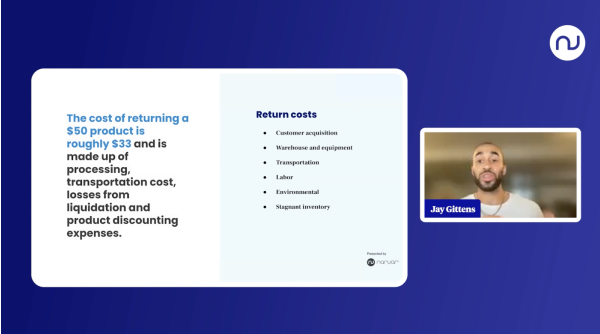
Maximized inventory. Recovered revenue. Cost savings and operational efficiencies.
Top logistics and fulfillment organizations hone in on these areas of opportunity within post-purchase to move the needle on their businesses.
Listen in on this episode where we cover these three areas top-performing logistics and fulfillment operations focus on that add to the bottom-line.
Claire Johnson (00:11):
Today, we are going to talk about where top logistics fulfillment organizations invest in post-purchase and why.
We’re also going to discuss what retailers are doing today, as well as what levers you can pull within your logistics and fulfillment organization to ensure delivery success for both outbound and inbound shipments.
Claire Johnson (00:43)
Let’s start with inventory maximization based on geography, SKU, quantities, and other relevant metrics.
How are you helping to maximize that inventory by unlocking both local and hyper-local inventory sources?
How can you reduce dead inventory time?
What are retailers doing to optimize their reverse logistics processes to cut costs and transit time?
Claire Johnson (01:31)
One main way that we see top logistics and fulfillment organizations—such as Urban Outfitters and The Container Store—operating in an innovative way is by unlocking same-day delivery.
(Sephora also does a great job of this, in fact, they just launched a subscription so that people can subscribe to same-day delivery.)
It’s clear that consumers want hyper-local delivery, so it's advantageous for you as a brand to be able to offer this to them so you can:
Claire Johnson (02:09)
To help retailers meet this need, Narvar offers a product that enables local delivery and same-day delivery by marrying you, your store locations, with different carriers at different rates. You can optimize the choices based on the location of the product and the cost of the carrier to ensure a really speedy fulfillment and delivery for the right price at the right time.
So, that's one really great way that you can unlock your local inventory. There are plenty of other same day delivery providers out there, but by all means, it's a really great way for you to make sure that you're moving inventory season after season.
Claire Johnson (02:46)
Another way you can do this is in your reverse logistics process.
Rather than view returns as a cost center, it’s important to think of them as a profit center: how can you make it so that you are reducing dead inventory time?
So, if someone is going to return an item, how can you:
Claire Johnson (03:15)
How can you optimize so a returned product goes back to the right location for the right cost at the right time?
The answer is intelligent dispositioning.
Assume someone orders a pair of black boots in a size seven, but they decide to return them.
As the retailer, you know that black boots fly off the proverbial shelf in particular metro areas—especially in New York.
So, how do you redirect that returned pair of boots to a specific store based in New York that’s in dire need of inventory?
Claire Johnson (03:55)
Or, let's just say it's a product that is sold season after season, so there is no rush to get it back to a warehouse and you can actually direct it back to the furthest warehouse or a specific warehouse with ground shipping.
So, you can save yourself one or two days, save yourself some dollars there as well, because there is no rush to really get that product back in a specific timeframe.
Claire Johnson (04:18)
Narvar works with a retailer that actually saved over 545 million miles in reverse logistics in terms of miles traveled by directing items back to the right place for the right time to really help ensure that level of optimization for time and costs in reverse logistics.
Maybe you have your own returns platform and you want to better learn how you can intelligently disposition. A lot of retailers are doing this today, notably like the Hudson's Bay companies. I know Macy's is actually exploring this. So, this is definitely something that you should take a look at and see how you can put it into place.
Claire Johnson (05:01)
Additionally, how can you reduce items from being returned?
If you know a product is defective and you don't want it returned, how do you automatically activate a “keep the item” policy when the customer initiates a return?
Within Narvar, this is possible and this is something that you can do at a skew level or at a return reason level. So, if someone is facilitating a return and they have noted that it's defective or damaged, they've sent a photo, you've approved it, you can actually just have them keep that item and dispose of it on their own or put it to work in another way versus having it sent back and having to have you help deal with it.
Claire Johnson (05:46)
Notably, we work with a big furniture retailer that ships a lot of glass items, so they ship a lot of glasses and candles and things like that. So, if an item is glass and it's been shattered in transit, they've made it so that the customer disposes of the item and receives a refund. It’s helped this retailer save a lot in terms of time, in costs, and just made it a better customer experience.
So, that's definitely something we would also recommend when it comes to saving you time and costs from a logistics and fulfillment perspective.
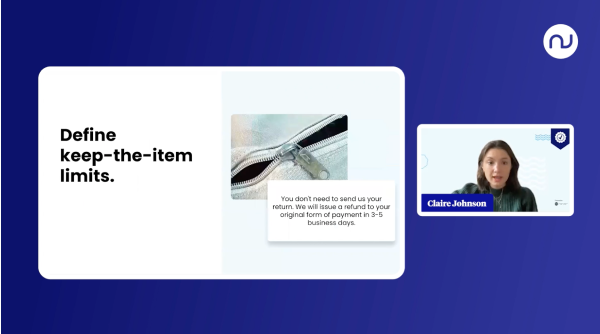
Claire Johnson (00:05):
Hi everyone. Welcome back to today's episode of Signed, Sealed, Delivered.
I’m your host, Claire Johnson, and today we're going to discuss why industry-leading brands focus on post-purchase:
In answering these questions, you’ll walk away with tips you can deploy in your own post-purchase strategy.
Claire Johnson (00:39)
The three things retailers always strive for—especially those in ecommerce—are:
Claire Johnson (01:00)
Claire Johnson (01:20)
Claire Johnson (01:46)
Let’s start with increasing customer lifetime value.
On average, it costs brands 5x more to acquire a customer than it does to retain one.
So, if you’re going to invest all that money to bring a customer into the fold, it makes sense to spend a little more to ensure they stay loyal—otherwise you need to go out and acquire a replacement customer.
Ask yourself what can you do to set the right expectations and then deliver on those expectations? Setting and meeting expectations is the foundation of a strong customer experience. If you can’t do that, there’s no way your shoppers will come back to make repeat purchases.
Claire Johnson (02:27)
To that end, think about your pre-purchase experience. Utilize estimated delivery dates on your product page, in your carts, at checkout, and at the time of order confirmation to let customers know when their order will arrive.
Doing this not only sets the right expectation with customers, but it actually helps fuel conversions by increasing the urgency around the initial purchase.
Claire Johnson (03:07)
Increase customer lifetime value and save your team time by providing clear, consistent communication throughout the delivery journey. Communicate from the time of order confirmation all the way through the final stage of fulfillment.
Claire Johnson (03:32)
We interviewed over 5,000 consumers, asking them different questions about the delivery journey—98% said they want to be over communicated with during the delivery journey, especially if there’s going to be a delay.
At Narvar, we recommend sending multiple messages to shoppers in order to create a consistent experience that makes people want to buy from you again going forward.
Claire Johnson (04:29)
We also recommend that you personalize your order tracking experience to your end customer.
You should treat your VIPs differently from new customers. For example, Dr. Squatch (a Narvar customer) does a great job with this. They segment their tracking experience to engage different types of customers in different ways, encouraging repeat purchases and driving a stronger clickthrough rate on their track page, leading to more sales and higher customer lifetime value.
Maybe you want to drive product adoption or awareness about aftermarket warranties or SKUs that can be purchased—personalization is your opportunity to do it all in a contextualized way.
Claire Johnson (05:23)
So we definitely recommend that and, at the very least, align this to your promotional content strategy.
If you can't segment based on customer, segment based on your promotional strategy—Halloween, back-to-school, Labor Day, etc. Drive engagement and capitalize on the traffic. Each track page is visited 4.1 times per order—that’s a lot of opportunity to offer customers personalized offers and promotions.
Claire Johnson (06:00)
Finally, how can you make it so that returns can be an avenue to both retain revenue and also friction reduction.
When we asked consumers "What is your propensity to make another purchase from a retailer, assuming the returns process is strong?" 96% of respondents said they’ll buy again from retailers that make the return process easy.
Claire Johnson (06:35)
One way to reduce friction in returns is to provide your customers with added levels of convenience.
So if your customers live omnichannel lives, make it so they can schedule a returns pickup—someone who will come to their home and pick up that return. Why? Because today’s consumer is busy, busy, busy! They don’t have time to get to one of your brick-and-mortar locations and they certainly don’t have time to go to the post office.
Or for those few customers who want to drop off their returns, you can eliminate the burden of needing to print return labels. Give shoppers a QR code they can use to return their purchase.
Claire Johnson (07:29)
All of this is a really, really great way to make it easier for someone to make a return and make them think after that process is done, "That was really easy. I'm definitely going to order from that retailer again," just knowing how simple it was.
One of those retailers that we work with is Orvis, and they have done a really phenomenal job of creating a returns process that really reduces friction and has made it a very seamless experience that makes it for their customers to want to come back and make more purchases.
Upon implementing Narvar returns, Orvis actually saw one, a dip in calls to their call center for what is the status of my return, or where is my return, by about 42% because of the communication that they started to do alongside their returns. So they let customers know, "Your return is on its way back to the warehouse." "Your return has been delivered." Which really kept customers in lockstep with what was going on with that refund when hundreds of dollars is on the line. So that's one big thing that they did.
Claire Johnson (08:29)
And again, they also just had this process of returning that made people want to come back and make another purchase.
Orvis saw a lift of 124% of purchases from people that had already made a return, which is really, really phenomenal. Also through this process, Orvis recaptured revenue by turning returns into exchanges, offering store credit, and making it so that the customer's share of wallet was still kept, while still adding to their bottom line.
Claire Johnson (09:00)
So with that, that is a wrap up on today's episode. If you have any questions or you want to learn more, by all means, feel free to reach out to us, request a demo, check out our support center if you have any product-related questions, and we will be back soon with our next installment.
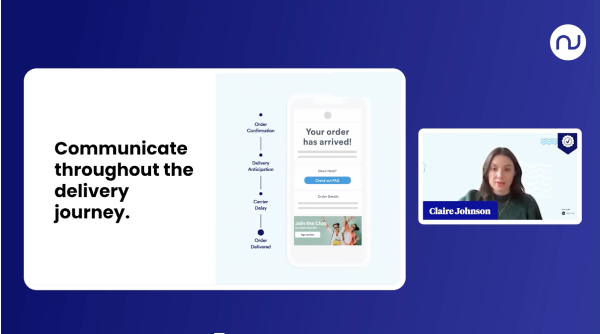
Customer Care and Customer Experience teams are the front-lines of any retail organization.
In this episode, we’ll focus on where and how these teams can create cost-savings, reduce WISMO, and drive customer loyalty.
Short on time? Get keyed into how WISMO is undermining your ecommerce success and our steps to remedy.
Claire Johnson (00:21)
Today we’re focusing on customer care’s seat at the post-purchase table, something that’s critical to informing and optimizing the rest of your post-purchase program.
First of all, your customer care team is your first line of defense when it comes to handling customers and triaging issues. That means they’re adept at uncovering “golden nuggets” you can use to improve your post-purchase experience…
…And one of the things your customer service team has no doubt identified is that "Where is my order?" (WISMO) inquiries are a top driver for your call center.
These types of questions are a way for you to unlock insights and better understand what your customers are looking for and what are the problems they’re experiencing, so you can make more informed decisions about post-purchase and the gaps that need to be closed.
Claire Johnson (02:17)
As an example of how effective this can be, you should consider the following two brands—On Running and Sephora.
The first, On Running, is a footwear brand with a strong direct-to-consumer channel and a wholesale channel. As a brand, they’re committed to giving their customers complete confidence across the purchase, order tracking, and returns experiences. They instill this confidence by setting strong pre-purchase expectations so customers don’t feel like they need to pick up the phone after an order is placed.
Claire Johnson (02:58)
Using a series of estimated delivery dates (EDDs) displayed on all product detail pages (PDPs), across the checkout flow, and on the order confirmation page, On Running is providing customers with a clear view into when they can expect their package.
Claire Johnson (03:44)
These EDDs are powered by a blend of Navar-specific logic and fulfillment logic to show an incredibly accurate delivery date and set the right expectation with customers so they don't feel the need to pick up the phone wondering where their order might be or when they can even expect to get that package.
Claire Johnson (04:08)
Sephora is another brand that does a phenomenal job of keeping customers in lockstep during the fulfillment and delivery journeys.
During the supply chain chaos of 2020 and 2021, Sephora encountered a number of fulfillment issues. To keep customers in the loop and out of the dark, they utilized Narvar's notification solution to send time-based communications to customers during the fulfillment process to let them know if there's going to be a fulfillment delay or just the status of their order as it's being fulfilled. These messages reduced WISMO and saved Sephora’s customer support team hundreds of hours of work.
Claire Johnson (05:06)
Letting shoppers know that an item is packed → shipped → leaving the warehouse → on the truck → arriving tomorrow → at the front door is critical to reducing the amount of calls coming to the call center. This creates a really positive and impactful customer experience downstream that makes a shopper want to come back and make a repeat purchase.
Claire Johnson (05:35)
Another element of customer care and customer care operations is how we can help you save time and how in post-purchase you can find more hours in the day to do more impactful things that save time and save money.
When it comes to solving customer issues in post-purchase—especially around order location—one of the biggest challenges is it requires tapping into multiple disparate systems (a warehouse management system, an order management system, a carrier system, etc.) to get a clear picture of what’s going on.
Claire Johnson (06:46)
Working with a platform like Narvar eliminates that complication.
When order issues come in, customer service reps can pull all the necessary order and shipment related information directly to solve the customer inquiry with incredible speed and precision. This, of course, reduces handling and resolution times, which improves operational efficiency.
This specific screenshot that you're seeing is through a partnership between Narva and Zendesk that our retailers will utilize to solve order issues as they arise, and customers can actually file their tickets directly from our Narvar track page and then all of this information would be surfaced directly to customer care agents, so we can really help streamline those operations.
Claire Johnson (07:25)
If you have any questions or would like to learn more or would like to have one of us just have a conversation with you to understand where you are in your post-purchase program, we absolutely can do that. So feel free to request a demo and one of us will get in touch with you.
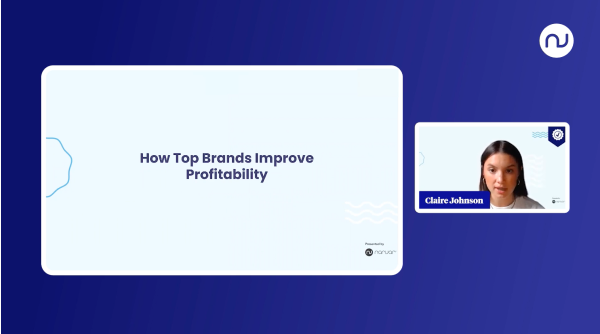
Post-purchase matters now more than ever.
When done right, it creates lifelong customers and generates operational cost and time savings. In this episode, we’ll talk through:
• What post-purchase is
• How brands that do it well see immediate results
• How you can get started
Don’t have time to tune in? Check out our explainer guide for all things post-purchase.
Claire Johnson (00:44)
Today we’re going to answer a few questions:
In answering those questions, we’re going to leave you with some valuable takeaways including what type of ROI does post-purchase deliver, and what can you do right now to drive revenue, improve efficiency, and boost your brand loyalty.
We're also going to leave you with a few resources that will help you learn more if you're interested—so with that, let’s dive into it.
Claire Johnson (01:27)
The rise of D2C brands made it incredibly easy for ecommerce to occur—anyone can stand up a digital storefront on Etsy, on Shopify, or any of the ecommerce platforms out there in a matter of minutes. But as with any increase in accessibility, there’s also been a surge in competition, which means how you differentiate yourself as an online seller is the key to brand loyalty and profitability.
According to a McKinsey study 40% of shoppers tried a new brand in the last year. To that end, post-purchase is a tool you can use to ensure those first-time shoppers become repeat buyers, lowering your need to spend on acquisition to foster revenue growth.
Claire Johnson (02:27)
And by that we mean the way that your customers remember you by providing:
When these actions are done well it can really keep your customers coming back.
Claire Johnson (02:59)
Post-purchase isn't just about the customer experience—it’s also about operations.
Common cost drivers such as WISMO (where is my order?) inquiries to call centers increase operational expenses year after year when left unaddressed, cannibalizing tens of thousands of dollars in revenue. (Never mind the fact that a customer who must ask “where is my order?” is a customer who’s suffering from a lackluster experience and is, therefore, less likely to buy again.)
Claire Johnson (03:47)
Bridging communication gaps related to your operations leads to a reduction in inquiries from customers which leads to an uptick in revenue for your brands. The retailers that we work with at Narvar see an average reduction of 50% in WISMO calls once they begin investing in their post-purchase experience.
Claire Johnson (04:11)
Returns are also a cost center many retailers are struggling to address. Fortunately, brands can lessen the impact on their bottom line by streamlining their reverse logistics processes. That means getting better at enforcing eligibility rules, activating automation, limiting packaging and postage, and cutting down on the back-and-forth customer service communication required to submit and process a return.
Claire Johnson (04:46)
Ask yourself how you can facilitate easy exchanges that allow you to keep customer’s share of wallet?
How can you offer conveniences that reduce friction in the returns process?
Can you provide something like printerless returns that eliminate just enough of that “return discomfort” that people want to make a second and third purchase in the future?
How can you make it so that you reduce debt inventory time and get products back to the right place at the right time using the right distribution node, so that they can get back on the shelf and resold faster?
Claire Johnson (05:27)
At Narvar, we work with many retailers who are optimizing their returns flow to different warehouses, stores, and distribution nodes to lessen the amount of time their products spend in-transit. Doing so is helping these retailers reduce carrier costs and get products back faster so they can be resold at a rapid rate. As you can imagine, doing this is benefiting their bottom line.
Claire Johnson (06:28)
So, who are the brands doing this well and what are some levers they pull?
Well, the biggest lever they pull involves setting—and controlling—customer expectations pre-purchase.
Claire Johnson (06:45)
For example, On Running is a D2C footwear brand that also operates a prominent wholesale channel as well. They pride themselves on instilling their customers with confidence—confidence when they make a purchase, confidence as they wait for an order to arrive, and confidence when a return needs to be made or a refund needs to be issued.
Claire Johnson (07:11)
From a pre-purchase perspective, On Running instills confidence by prominently displaying the most accurate estimated delivery dates possible and providing total transparency on costs related to the various shipping options. All of this helps drive site conversion and reduce cart abandonment rates.
Claire Johnson (08:11)
Additionally, when it comes to providing a luxurious, consistent, and transparent delivery tracking experience, Clarins (the prominent French beauty retailer) does a phenomenal job of brand extension. They do this through a series of communications that keep their customers in lockstep with their orders, letting them know when orders are fulfilled, shipped, delayed, and delivered. This brand extension is helping Clarins reduce WISMO and drive additional engagement that’s powering supplemental sales.
Claire Johnson (09:05)
A main mechanism driving this engagement for Clarins is a beautiful, branded, and bespoke order tracking page. It offers personalized recommendations and content that's unique to that specific customer (which makes them want to revisit Clarins' website and make repeat purchases).
Clarins is seeing a 300% increase in site conversion rates from post-purchase traffic—an incredible figure. Anyone coming through these order tracking communications (or through a dedicated tracking page) has a higher propensity to convert than other types of traffic.
Claire Johnson (09:43)
But most importantly, each tracking page that Clarins uses acts as a real-time mechanism for customers to get the insights they need into when they can expect their package to arrive.
So, Clarins is just a really great example of how you can get up and running with post-purchase quickly and in a way that has immediate financial impact.
Claire Johnson (10:05)
Finally, Orvis is doing a phenomenal job of facilitating a smooth and seamless returns experience for their customers, while driving operational efficiencies related to reverse logistics.
They are accomplishing all through the provision of a beautiful, branded returns portal that makes it easy for customers to see which products are eligible for return, what return methods are available (printerless, drop-off, home pickup, etc.), how long their return will take to process, and what options they have in the way of receiving a refund (original payment method, gift card, etc.). The eligibility piece is really crucial as it guarantees final sale or out-of-policy items can’t be returned.
Claire Johnson (11:06)
In addition to all this, Orvis provides accurate, real-time communications that keep customers in lockstep with their returns—from the moment a return is dropped off at a carrier, to the moment it arrives at a warehouse, to the moment the refund is issued. This way, the customer is never “out of the loop” when it comes to their return or their refund.
All of this is combining to give customers a really exceptional return experience that’s leading to an uptick in sales—the customers who return an item now repurchase with a higher propensity than they did before Narvar, lifting new orders following a return by 124%.
Claire Johnson (11:51)
The best part of the Orvis story lies in revenue recapture.
By enforcing eligibility and offering seamless exchanges, Orvis recovered $185,000 in revenue and reduced WISMR (where is my refund?) inquiries to their call center by 42%.
Claire Johnson (12:32)
In closing, I want to leave you with some resources in the event you want to learn a little bit more.
We have a ton of material on our blog which you can access here, as well as great ebooks and webinars.
And then if you'd also like a consultation as well with one of our post-purchase experts, we are more than happy to do that, to have a conversation with you, see where you're at, and even just make some recommendations for up-leveling your post-purchase based on whatever your goals might be.
